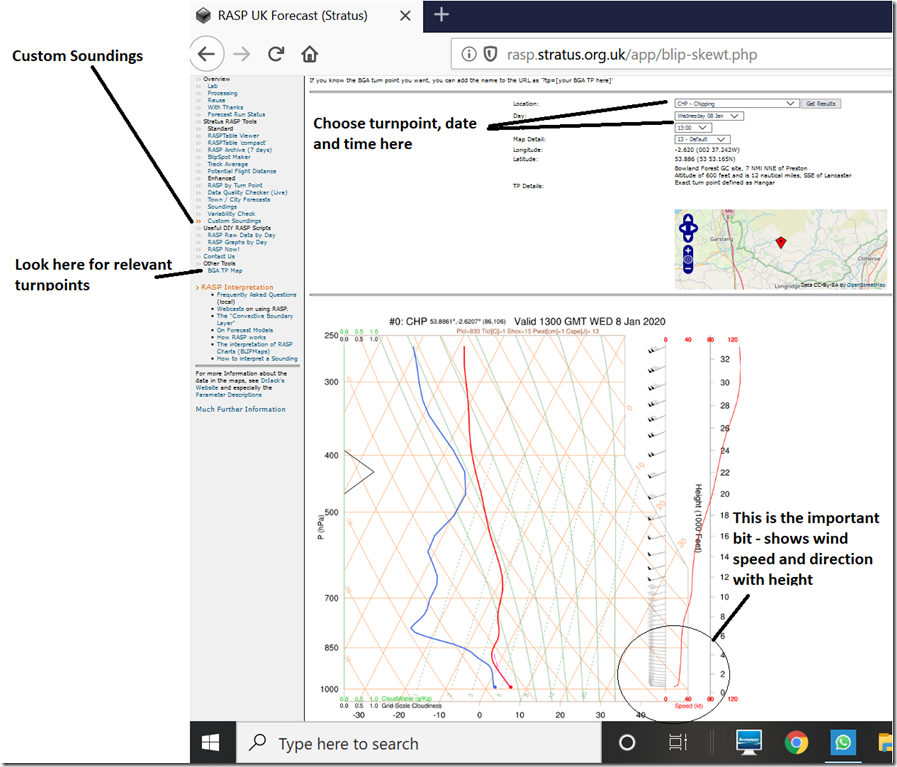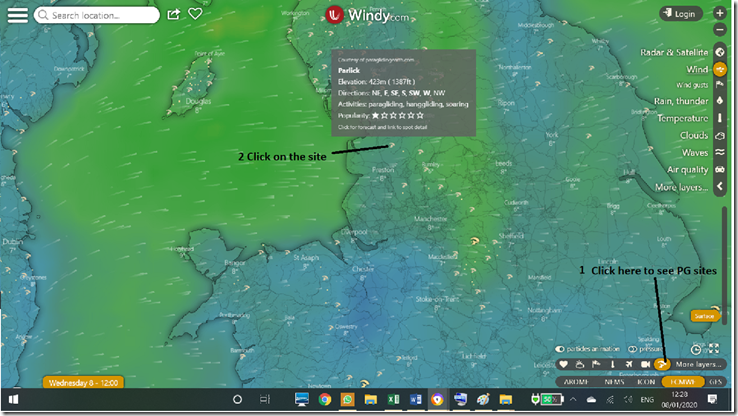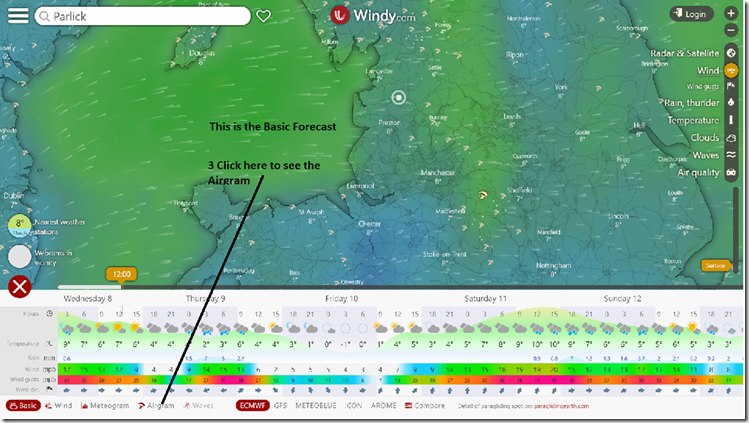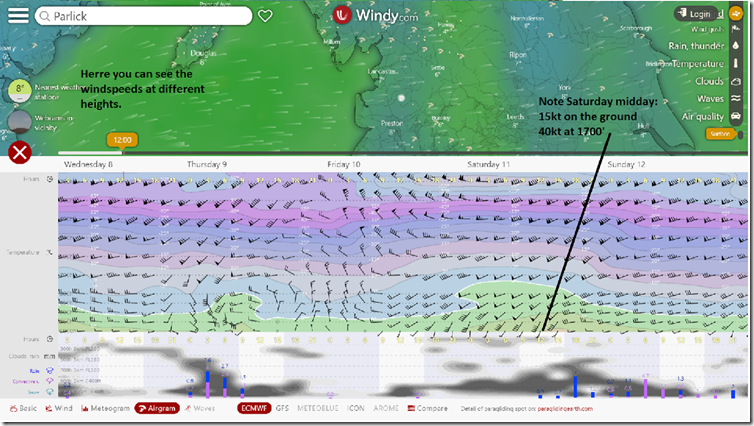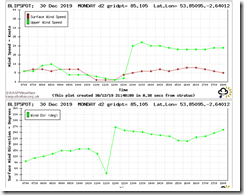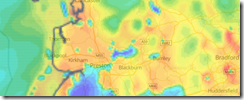RASP also has tools for displaying the wind at altitude. You may have to choose the right browser. I find it works OK in Firefox, otherwise if you right-click the partial image that comes up you can choose to display it in a new window and see the whole thing.
Using Windy
By Brian Stewart on January 8, 2020 15:53
How to find forecasts of winds at altitude.
Windy provides an easy-to-use graphical format to show wind speeds and directions in the layers of the atmosphere right up to 40000’. Of course we only really want to see the bottom few thousand, but here’s how to find it for any PG site on www.windy.com:
Opening Screen (you need to zoom in to the right part of the country)
After clicking on the site, you get the basic ground level forecast for there, and can compare the forecast models:
The Airgram shows the wind speeds and direction at every level. 950 hPa is about 1770’; 900hPa = 3250’
Of course you know how to read the direction and speed from the barbs on the diagram, don’t you . . . ?
Jan 2020–Let’s not be home to Mr Cockup this year
By Brian Stewart on January 4, 2020 14:20
Happy New Year Pennini! So, what did you get away with last year? I’m not thinking about massive issues like a mid-air collision or a reserve ride, I’m wondering about the little ‘incidents’ that we just laugh off, or maybe don’t even notice. Things like turning the wrong way on launching – even the 1000-hour pilots can get this wrong, often after slope landing and dashing back to launch to grab that thermal that’s just taken your mates to ‘base. Most times the worst that happens is a stumble, an aborted launch and a furtive look round hoping that no-one noticed. But it could mean a serious dragging into the boulders, or a totally uncontrolled launch and cascade into the ground followed by a helimed ride.
Or: been going backwards lately (lots of that going on this winter)? Visited the white room? Run out of landing options? I read a book recently called ‘Deep Survival’ about what separates victims from survivors; one sentence that stood out was about how having a lot of experience might just mean you’ve got away with making the same mistakes more often. Then there’s the unknown unknowns, the take-offs where you didn’t check for clear air, but there was no-one there anyway; or the failure to check the reserve, but it was OK; or skipped a stage of your pre-flight check, your daily inspection your . . . you get the picture – aviation is a serious business and it doesn’t take much to spoil your day; relying on luck won’t work for ever.
A good resolution might be to try to minimise the ‘got away with it’ moments this year. Starting the season by getting your wing serviced and reserve repacked (and practise throwing it). Then when it comes to flying, checking the night before the forecast winds at all levels, not just the ground; equipment all sorted; head in the right place. Then on the day having a check list and using it; paying attention to everything that’s going on around on launch and in the air. Safety isn’t an accident, and if you think safety is a pain, try having an accident . . . Let’s not be at home to Mr Cockup when he calls.
On another note, why is it that we in the Pennines seem uniquely reluctant to broadcast our presence in the air? Turn on the excellent xcrt.aero app and you’ll see little groups of PG icons (and the odd HG) all over the south, Derbyshire, Dales. Lakes etc, but a peculiar blank spot on our hills. Apart from being useful info (i.e. it is/isn’t flyable) there are good safety reasons for others being able to see where you are. Android phone users can simply download the excellent AirWhere app to transmit to the AirWhere page while SPOT/InReach users already know this. Best bet is to sign up to Livetrack24 so your position and track are visible.
Pre-Cold Front
By Brian Stewart on January 2, 2020 15:19
Pre cold-frontals
Just before the new year I headed up to Parlick to get some much needed fresh air, and maybe a bit of airtime. Walking up with Simon, he noted the wind turbines were showing an easterly direction, but we were feeling a light westerly on the hill. We arrived on the west face and Simon also noted that the clouds were moving quickly and that a cold front was approaching from the north; as could be seen from a thick band of cloud heading our way. The wind was light on the hill and Simon flew over to Fairsnape. I followed behind but had to land as it was too light. After a couple of minutes the wind picked up a little. Simon had wisely landed, after seeing increasing cloud speeds. I launched, then pushed out when I could feel the wind getting stronger, and this is when the conditions changed suddenly. I was hit by a series of gusts from all directions and wind speeds I’ve never experienced before. I looked up to see the wing tucking, pitching and rotating violently. This lasted a minute or so until at a lower altitude. As soon as I regained flight I put big big ears in and full speed bar to get as far away from the hill as possible before landing.
Analysis of the day.
What I did wrong..
After getting up in the morning, a brief look at xc weather showed light winds, but strong gusts. My thoughts where I will land if it gets strong, how bad can it get, it’s winter. That was my first mistake.
The next was that the low clouds were moving at a fair pace, but still very light on the hill, all warnings of wind shear that wasn’t registering in my head. Looking at the soundings for the area, it showed that at around midday the upper winds would veer and strengthen over a short time period. This was all forecasted surprisingly accurately, but I hadn’t bothered to check the forecasts. After some following research, I was reminded that approaching cold fronts do cause sudden change in wind direction and strength, creating severe turbulence and wind shear.
What I did right..
Hands up, allow the wing to recover, brake the dive, try to stay calm.
I thought afterwards whether I should have thrown my reserve, if low throw. Being level and close to the hill, any deployment could have been risky, hitting hard against the slope, followed by a dragging. I can only speculate on whether it was the right decision as not throwing was also risky.
Strong winds at 2k, light winds at ground level
Upper wind changes in speed and direction.
Wind shear forecast around midday
